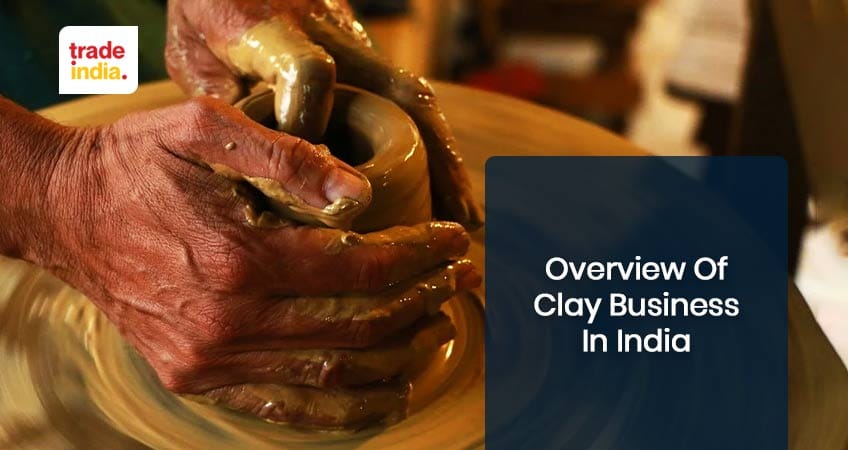Essential Things You Ever Wanted to Know About Clay

Everything You Ever Wanted to Know About Clay
Clay is fascinating, humble, and ubiquitous. You think you know everything about it, but there’s much more to it than we know. Read on to find out all about it.
Clay is a smooth-grained natural soil substance rich in magnesium, alkaline earth, iron, and alkali metals. When wet, it is highly elastic due to the presence of a molecular film of water that engulfs the clay particles. When dried after firing, these clay particles turn hard and brittle. Almost pure clay substances are light in colour or white, though natural clays show various colours from impurities, often reddish-brown due to iron oxide. You can recognize clay as being a kind of sedimentary rock that comprises tightly packed mineral particles. Of them, the most commonly used is kaolinite.
Origin of Clay
The oldest known ceramic material, clay was first discovered by prehistoric humans who used it to make pottery. Around 14,000 BC, clay tablets were used as a writing medium.
In modern times, clay is part of several industrial processes, including cement manufacture, paper, and chemical filtering. In most countries, clay is baked to form mud bricks which are used in the construction business.
Where Does Clay Come From?
Clay is present in the earth and generally near water bodies. It is a combination of plant life, minerals, and animals. With time, water pressure shatters the remains of minerals, plants, and animal life and reduces them to a fine powder.
While large shards are thrown out with sand and rocks, the silt settles in clay beds. The quality of the clay depends on two factors:
- The distance the silt has travelled from its source
- The purity of the silt
Also Read: Top 10 Ceramic Manufacturers, Suppliers & Exporters In India 2023
Types of Clay
Clay may be a prevalent substance, but it has several types, each with its properties and uses. Here are the best-known among them:
1. Shale
This is the most common sedimentary rock formed from clay.
2. Loam
This is a mix of silt (that does not contain clay), sand, and not more than 40% clay.
Apart from these, there are other clay types with their strengths. These are:
3. Earthenware
You’ve probably come across this term concerning pots for your garden. Terracotta pots stand out for their earthy colour. This clay mixes well and is somewhat sticky. It contains iron and other impurities, which let the clay reach hardness temperatures between 1745°F and 2012°F.
4. Stoneware Clay
This clay type is plastic and is recognized for its grey colour and moistness. When fired, it can be light grey or sandy.
5. Ball Clay
This clay type shrinks a lot when drying and firing, so it is best used in combination with other substances.
6. Fire Clays
These clays have a high firing range and peak at 2696°F (1500°C). They do not have any impurities but iron spots that manifest as specks when fired.
7. Kaolin Clay
These are excellent for porcelain because of their mineral purity. Generally light-coloured, it has some colour variations. When still damp, they are light grey, and when fired, they turn almost white.
8. Paper Clays
Also called fiber clay, this refers to any clay body to which paper is added. Other clay types such as earthenware, stoneware, terracotta, bone china, and porcelain can be used to make paper clay.
The fiber adds to the tensile nature of the dry clay. When left to dry naturally, they become stiff and lightweight, allowing only the minimum shrinkage during the drying stage. This clay type finds application in doll making and crafts for pottery and ceramic art.
Properties of Clay
i. Plasticity
Plasticity refers to the ability of wet clay to undergo a total change in its form without displaying any cracks. To give clay good plasticity, add 15%-35% water to it.
ii. High Resistance to Break Under Tension
Clay is generally exposed to significant stress while handling, molding, and drying. This can cause cracks in it. However, cracks do not form in clay due to its high resistance to breaking under tension.
iii. Temperature
Temperature affects clay’s properties, particularly when you consider the temperature at which it melts or fusibility. If the material of the clay does not have uniform composition, the different particles it contains will melt at different temperatures. It will therefore take much longer to convert from liquid to plastic when molding a brick.
iv. Porosity
The porous quality of clay depends on the quantity of water needed to make it plastic. Indirectly, this also influences air shrinkage. The advantage of large pores is that they allow the water to evaporate quickly and dry faster too.
v. Shrinkage
This feature depends on the availability of water in the clay and its pore space. The shrinkage amount determines the clay mold’s degree of burning.
vi. Pliable
Clay can be easily twisted, shaped, reshaped, and molded according to our needs. Its unusually high absorbent capacity renders it highly useful in the construction sector.
vii. Fire-Resistant
Since it is highly fire-resistant, it is ideal for use in projects that need firing, such as creating pottery.
viii. Highly Water-Absorbent
Clay is notable for its ability to absorb water and swell when wet, which makes it ideal for use in pottery and ceramics. When fired in a kiln, clay becomes rigid and strong, making it an excellent material for making clay bricks and other building materials.
ix. Versatile
Since clay is pliable and water-absorbent, one can use it in a variety of ways, rendering it versatile. While it goes to make rugged but durable items, it is also used to make ceramics and pottery. It is also widely used in making building materials like bricks, tiles, etc.
Applications of Clay
We see the use of clay in different aspects of our lives—whether a humble earthenware pot in which we may cook or bricks used at large construction sites.
Here are many more applications of clay:
- It is the basic ingredient of ceramics, paper, and cement.
- Being highly absorbent, it can absorb and clean up oil spills.
- It is used to make terracotta utensils for cooking, baking, or storing.
- Flowerpots are made of clay.
- Fine dinnerware uses porcelain which is made of china clay.
- Floor and wall tiles are made with clay.
- Folk medicine uses clay to relieve an upset stomach and wound infection.
Cosmetics That Use Clay
Clay has long been used in cosmetics; in fact, it has been utilized for hundreds of years. They offer various beneficial properties for all skin types and people of all ages.
Even today, clay is a significant ingredient in facial masks, DIY soaps, homemade baby talc, and dry shampoos.
Let’s look at the most popular clays for cosmetic use:
A. Bentonite Clay
Bentonite clay is made up of volcanic ash sediments that have eroded over time. This clay is known to distend, and in combination with water, it is highly absorbent, almost like a sponge. It is used for bath soaking blends, facial masks, and foot baths.
B. White Cosmetic Clay
Better known as kaolin clay, white cosmetic clay isn’t as absorbent as Bentonite clay or other clay types. This property makes it excellent for dry and sensitive skin. Hence, this clay is generally used for mineral makeup.
C. Fuller’s Earth Clay
People with oily complexions can benefit greatly from using Fuller’s Earth Clay as it has a high absorbent capacity, so it can dry their naturally oily skin. It also helps remove facial blemishes and has mild and natural bleaching traits.
D. Rhassoul Clay
This fiery red moroccan clay has a reputation for being used in natural skin care for centuries. It absorbs natural oils from the skin but is gentler on the skin than other clays. Thus, it is ideal for people with sensitive skin and older people.
Conclusion
To sum up, now that you have all the virtues and uses of clay at your fingertips, you know how best to make it part of your life. Invite clay into your life as a cooking pot, beauty mask, medium for art and pottery making, and soil to grow a garden.
FAQs: Clay
Q. Why is clay important?
Ans. Clay contains nutrients that stimulate plant growth. Hence, it is crucial to our environment and to increase plant life.
Q. What is clay made from?
Ans. Clay minerals comprise alumina, water, silica or magnesia, or both. It also contains iron substitutes instead of magnesium and aluminum. Besides, it contains sodium, potassium, and calcium.
Q. Is clay a mineral or rock?
Ans. Clay minerals are important minerals contained in clay as they evolve due to chemical weathering. For this reason, they are the prime components of smooth and tiny-particles sedimentary rocks we know as mud rocks. Mud rocks include clay stones, shale, and mudstones.
Q. What type of rock is clay?
Ans. A sedimentary rock, clay comprises tiny particles that come together due to the erosion of rocks and associated minerals.
Q. How expensive is clay in India?
Ans. Kaolin clay powder costs Rs. 4-Rs. 50 per kg. Clay price depends on its particle size, derivation process, and chemical properties.

